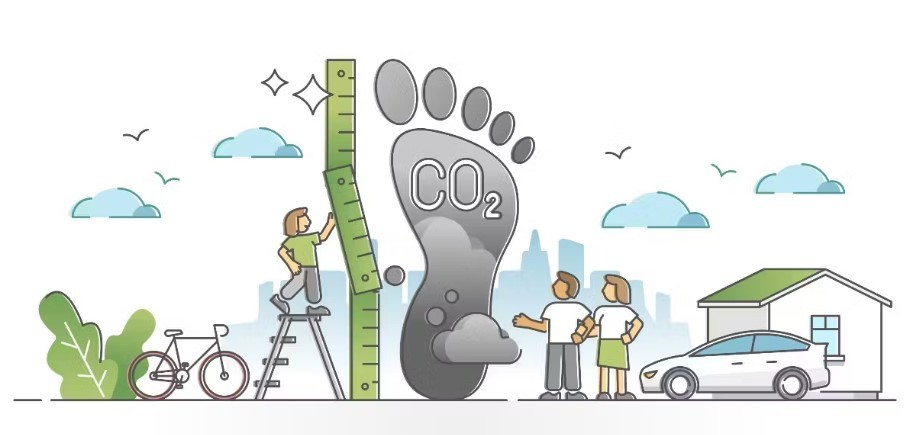As the world faces the growing challenges of climate change, attention is turning to the carbon footprints of our homes, buildings, and properties. According to the International Energy Agency (IEA), the buildings and construction sector accounts for nearly 40% of global carbon dioxide (CO₂) emissions. With increasing pressure to reduce these emissions, tracking the carbon footprint of properties has become a crucial step toward achieving environmental sustainability.
This article explores why and how carbon footprints of properties are tracked, the tools and methods available, the benefits of doing so, and the challenges involved.
What Is a Carbon Footprint?
A carbon footprint refers to the total greenhouse gas (GHG) emissions caused directly or indirectly by an individual, organization, event, or product. For properties, this includes emissions from energy consumption (electricity, heating, cooling), construction materials, waste generation, water usage, and even land use changes.
These emissions are typically measured in terms of carbon dioxide equivalents (CO₂e), which account for all major greenhouse gases like methane (CH₄) and nitrous oxide (N₂O) by expressing them in terms of the global warming potential of CO₂.
Why Track the Carbon Footprint of Properties?
Environmental Responsibility
Reducing a property’s carbon footprint is one of the most effective ways to combat climate change. By identifying high-emission activities, property owners and managers can implement strategies to mitigate them.
Regulatory Compliance
Many countries are introducing regulations that require disclosure of a property’s energy usage and carbon emissions. For example, the European Union’s Energy Performance of Buildings Directive mandates energy performance certificates for buildings.
Financial Incentives
Tracking carbon footprints can help property owners qualify for green certifications (like LEED or BREEAM), which can increase property value and provide access to government incentives, tax breaks, or lower insurance premiums.
Tenant and Buyer Demand
Modern consumers and corporate tenants are increasingly prioritizing sustainability. Properties with lower carbon footprints are more attractive, offering competitive advantages in the real estate market.
What Factors Contribute to a Property’s Carbon Footprint?
The carbon footprint of a property includes emissions from:
-
Energy Use: Electricity and heating fuels (natural gas, oil, coal).
-
Construction Materials: Cement, steel, glass, and other materials that require significant energy to produce.
-
Water Usage: Energy used in water heating and pumping.
-
Waste Generation: Both solid waste and wastewater contribute to GHG emissions.
-
Appliances and Systems: HVAC systems, lighting, and electronics.
How to Track Carbon Footprints of Properties
Energy Audits
An energy audit assesses how much energy a property consumes and identifies opportunities to improve efficiency. These audits often include thermal imaging, analysis of utility bills, and inspection of HVAC systems and insulation.
Carbon Accounting Software
Specialized platforms, such as Carbon Trust, SIERA, or Energy Star Portfolio Manager, help calculate a property’s GHG emissions. These tools use standardized emission factors and can track performance over time.
Smart Meters and IoT Devices
Smart meters provide real-time data on energy consumption. Combined with Internet of Things (IoT) sensors, these devices can monitor lighting, heating, and water usage, helping to pinpoint inefficiencies.
Life Cycle Assessment (LCA)
For new constructions or major renovations, a Life Cycle Assessment evaluates the environmental impact of materials and processes used throughout a building’s life, from construction to demolition.
Benchmarking Tools
Benchmarking compares a property’s emissions against similar buildings, helping owners understand their relative performance and set reduction targets.
Steps to Reduce Property Carbon Footprints
Once emissions are tracked, the next step is implementing reduction strategies. Some common measures include:
-
Improving insulation and installing energy-efficient windows.
-
Upgrading to LED lighting and ENERGY STAR appliances.
-
Switching to renewable energy sources such as solar or wind.
-
Implementing smart building systems for automated lighting and climate control.
-
Using low-carbon or recycled construction materials.
-
Reducing water consumption with low-flow fixtures.
Green retrofitting, or updating existing buildings with sustainable technologies, can significantly lower emissions and enhance property value.
Challenges in Carbon Tracking
Data Availability and Quality
Accurate tracking requires comprehensive data, which may be unavailable, especially in older buildings or regions with limited digital infrastructure.
Standardization Issues
Different tools and methods can produce varying results. Lack of a universal standard complicates benchmarking and comparisons.
Upfront Costs
Energy audits, smart devices, and software can involve initial costs. However, these often lead to long-term savings.
Tenant Cooperation
In multi-tenant properties, tracking emissions accurately requires coordination among all occupants, which can be logistically complex.
Future Trends and Innovations
With advances in AI and machine learning, predictive energy modeling is becoming more accurate and accessible. These technologies can forecast energy usage patterns and suggest optimal efficiency improvements.
Blockchain is also emerging as a tool for transparent carbon tracking and trading, enabling properties to participate in carbon credit markets.
Meanwhile, governments and cities worldwide are introducing stricter carbon disclosure mandates, pushing more property owners to adopt emission-tracking practices.
Conclusion
Tracking the carbon footprints of properties is no longer a niche activity for eco-conscious developers—it’s becoming an essential component of responsible property management. From reducing energy costs and complying with regulations to enhancing tenant satisfaction and protecting the environment, the benefits are significant.
As technology and policy frameworks continue to evolve, the tools for monitoring and managing building emissions will become more refined, accessible, and integral to the real estate landscape. By taking steps today, property owners can help build a more sustainable and climate-resilient tomorrow.
Frequently Asked Questions
What is a carbon footprint in the context of properties?
A carbon footprint in the context of properties refers to the total amount of greenhouse gas emissions generated by a building during its life cycle. This includes emissions from:
-
Energy consumption (heating, cooling, lighting, appliances)
-
Construction materials (like concrete and steel, which have high embodied carbon)
-
Water usage and waste management
-
Operations and maintenance activities
The footprint is measured in carbon dioxide equivalents (CO₂e), which standardize the impact of various greenhouse gases like CO₂, methane (CH₄), and nitrous oxide (N₂O) based on their global warming potential.
Why is it important to track the carbon footprint of a property?
Tracking a property’s carbon footprint is important for several reasons:
-
Environmental Impact: It helps identify emission sources and enables actions to reduce a building’s contribution to climate change.
-
Regulatory Compliance: Many governments now require energy and carbon reporting for certain types of buildings.
-
Cost Savings: Efficiency improvements discovered during tracking can reduce utility bills over time.
-
Marketability: Sustainable buildings often attract tenants or buyers willing to pay a premium.
-
Access to Incentives: Some regions offer tax breaks, subsidies, or certifications for low-carbon or energy-efficient buildings.
What are the main sources of emissions in a typical residential or commercial building?
The main sources include:
-
Energy Use: From HVAC systems, lighting, and appliances.
-
Construction Materials: Especially concrete, steel, and glass, which have high embodied carbon.
-
Water Heating: Which consumes electricity or gas.
-
Operational Waste: Including organic waste and general refuse, which can emit methane in landfills.
-
Transportation Links: Emissions from commuting to and from the property (particularly in urban planning).
How is the carbon footprint of a property measured?
It is measured through a combination of:
-
Utility Data Analysis: Collecting and analyzing electricity, gas, and water bills.
-
Emission Factors: Applying standardized values that convert energy or material usage into CO₂e emissions.
-
Carbon Accounting Software: Tools like Energy Star Portfolio Manager or Carbon Trust platforms automate data collection and provide detailed emissions reports.
-
Life Cycle Assessment (LCA): Evaluates the emissions associated with building materials and construction processes.
The output is usually reported as kilograms or metric tons of CO₂e per year or per square meter.
What is the difference between operational and embodied carbon in buildings?
-
Operational Carbon refers to emissions generated during the day-to-day running of a building—primarily from heating, cooling, lighting, and powering appliances.
-
Embodied Carbon refers to emissions released during the production, transportation, and installation of construction materials, and even during renovation or demolition.
Reducing operational carbon is often the focus for existing buildings, while new construction projects must consider both types.













